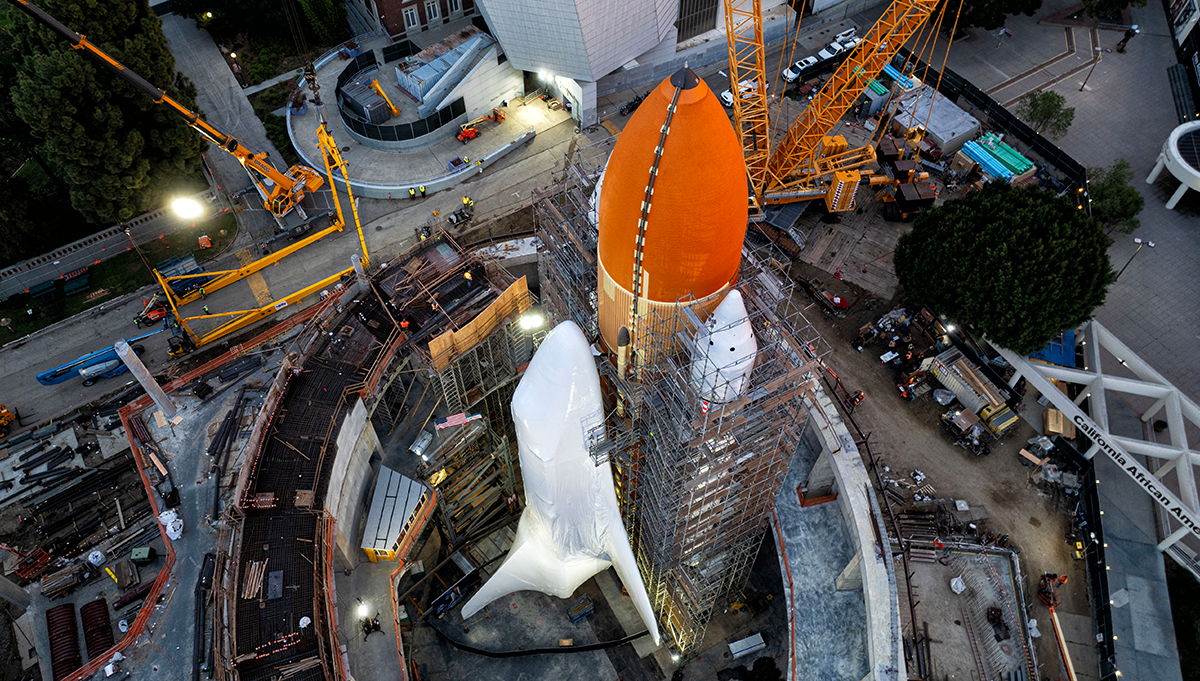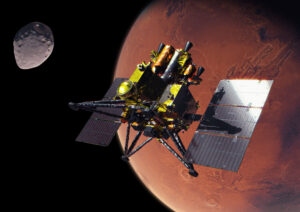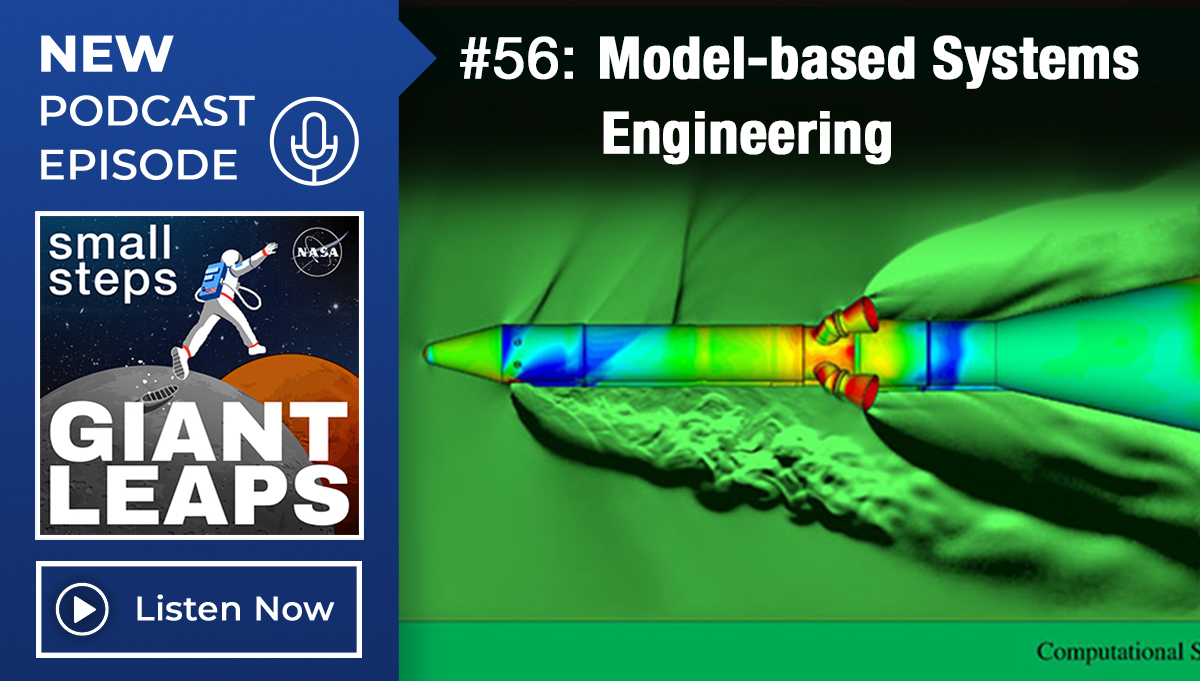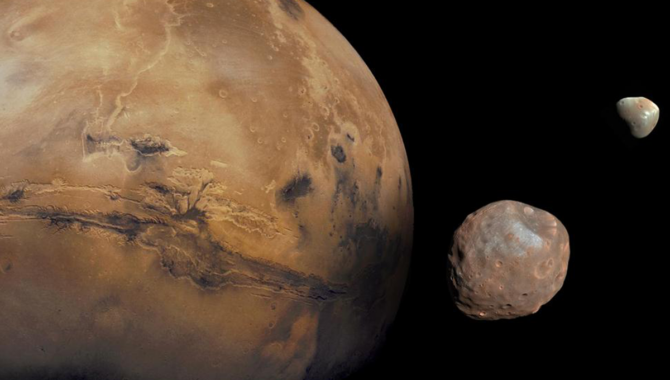
Mars is kept company by two cratered moons – an inner moon named Phobos and an outer moon named Deimos. Credit: NASA/JPL-Caltech/GSFC/Univ. of Arizona
NASA contributes instruments to JAXA sample return effort.
In early August of 1877, astronomer Asaph Hall was frustrated by the undiscovered moons of Mars. Astronomers and authors at the time, using reasoning that would later prove to be flawed, correctly suspected Mars would have two moons. But even using the new, powerful 26-inch refracting telescope at the US Naval Observatory, Hall’s search early that month had been futile. As the days passed, he realized that if the Red Planet had moons, they were in a close orbit, making them especially difficult to observe.
Tempted to give up, it was Hall’s wife, mathematician Chloe Angeline Stickney Hall, who encouraged him to continue the search. This persistence paid off during the second weekend of the month, when Hall recorded the first fleeting glimpse of Deimos, before fog obscured the night sky. It would be nearly a week before he verified the sighting with an extended observation. The next night, looking for Deimos again, he discovered a larger moon, Phobos.
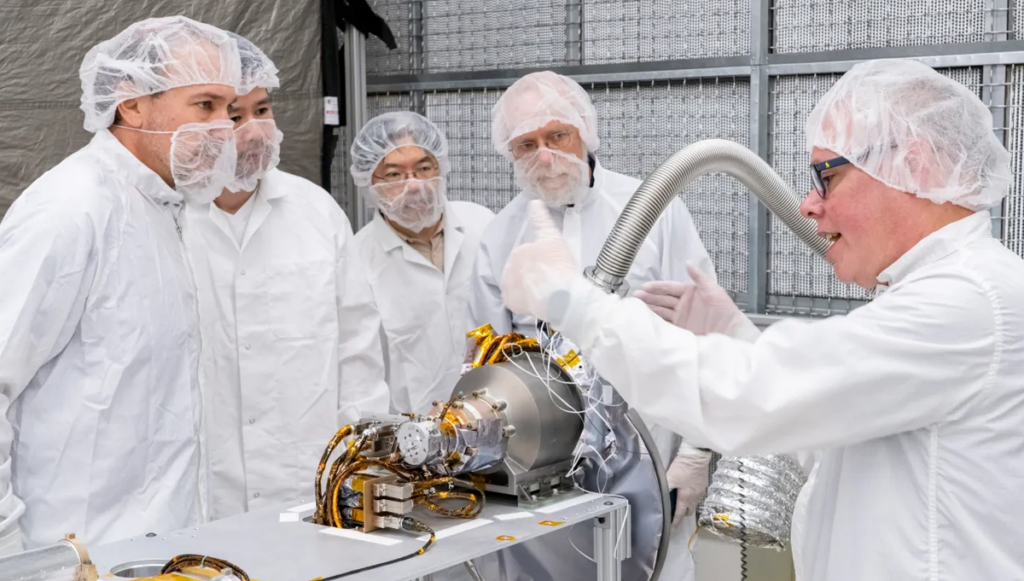
U.S. and Japanese team members gather around and discuss the gamma-ray spectrometer portion of the MEGANE instrument during its development at Johns Hopkins APL.
Photo Credit: NASA/JAXA/Johns Hopkins APL/Ed Whitman
The moons of Mars have intrigued astronomers ever since. Phobos is irregularly shaped and heavily cratered. The largest impact crater is approximately 6 miles in diameter, covering half the moon’s surface. The impact was likely so violent that Phobos nearly split in two. It orbits Mars three times a day, traveling just 3,721 miles above the surface. That’s close enough that Phobos rises in the west and sets in the east several times a day. Phobos is on a 50-million-year collision course with Mars, drawing about 6 ft closer to the planet’s surface every 100 years.
Deimos is about 1/7th the size of Phobos. It orbits much further out—14,291 miles from the surface—circling the planet in approximately 30 hours. Less heavily cratered, the surface of Deimos is more regular and smoother.
Because the moons are so small, and orbit so close, it is unclear if they were asteroids that passed near Mars and were captured by the planet’s gravity, or if they are the remnants of a violent collision between an object in the early solar system and Mars. Either way, Deimos and Phobos likely hold important clues to the Red Planet’s past.
Earlier this month, NASA delivered a gamma-ray and neutron spectrometer to Japan, where it will be integrated into a spacecraft that will survey the moons of Mars later this decade, collect samples from Phobos, and return the samples to Earth. The Japan Aerospace Exploration Agency (JAXA) is developing the Martian Moons eXploration (MMX) mission to gather data to better understand Phobos and Deimos and determine their origins.
The spectrometer is known as MEGANE, an acronym for the Mars-moon Exploration with Gamma Ray and Neutrons. It was developed via NASA’s Discovery Program by a team at the Johns Hopkins Applied Physics Laboratory in Laurel, Maryland, working with colleagues at the Lawrence Livermore National Laboratory in California.
When galactic cosmic rays, which move through the universe at nearly the speed of light, hit an object such as Phobos, it produces high-energy neutrons, which then interact with the surrounding materials on the moon’s surface, causing gamma ray emissions. By measuring the properties of the neutrons and gamma rays emitting from Phobos, MEGANE’s state-of-the-art detector will enable the MMX team to determine the presence and abundance of major elements such as hydrogen, oxygen, magnesium, silicon, potassium, calcium, and iron. Comparing this data with data from Mars will help point to a likely origin of the moons.
“MEGANE will be a key instrument on MMX, making a big contribution toward the goal of understanding the origin of the Martian moons,” said Thomas Statler, MEGANE program scientist at NASA Headquarters in Washington, in a NASA press release. “NASA is glad to see MEGANE ready for integration, another step in NASA’s continuing collaboration with JAXA on this groundbreaking mission.”
The MMX spacecraft will carry a suite of instruments, including both telescopic and wide-angle cameras to observe the geological features and surface characteristics of Deimos and Phobos, LIDAR to gather detailed data about their surfaces, a near-infrared spectrometer to learn more about their mineral composition, and a mass spectrum analyzer to measure the presence of ions and search for indications of ice within the moons.
The mission will also carry a small rover, jointly developed by the National Centre for Space Studies and the German Aerospace Center. The rover will explore the surface of Phobos, gathering data in advance of a landing by the MMX spacecraft, which will be equipped with two devices to collect samples. The C Sampler will collect a 2 cm deep core sample in a tube. The P Sampler, which will be contributed by NASA, will use pressurized gas to lift surface material and collect it in a sample container.
The spacecraft will then lift off from Phobos and gather data during several flybys of Deimos before a Return Module carrying the Sample Return Capsule begins the journey to Earth. Launch is currently planned for 2026, with the Sample Return Capsule’s landing on Earth planned for 2031. The mission builds on the success of JAXA’s Hayabusa and Hayabusa 2 asteroid sample return projects.
To learn more about MEGANE, click here. For more information about the MMX mission, click here.


